To be honest, I was feeling pretty good after my first post in this series, Jamie’s Investigations, Part 1: Emergence, for it seemed to me that I’d pulled a pretty snazzy rabbit out of the hat. But as I continued looking through Jamie’s art and started thinking about further posts, those good feelings began to dissipate. What am I going to do to top THAT? What if there are no more rabbits in the hat? Because that’s how it looks at the moment: no more rabbits. If that’s the case, then we’ve just got to get as much fun out of this one rabbit as we can.
By rabbit I mean the idea that Jamie is following a local rule when he draws, but the general context is such is that those local choices result in (sometimes surprising) global order. Thus in the case of the dots pictures, the local rule is, don’t have adjacent dots be the same color. The global result is an overall rhythm to the image that’s easy to see and sense, but hard to describe.
With that in mind, let’s look at Jamie’s early work, done between 2003 and 2005, between the ages of 11 and 14. As Michael notes “all his modes of drawing and doodling and entertaining himself are here in embryonic form.” But let’s start with the one drawing that is NOT a precursor to later work:
Only one of these works is dated– the drawing on the left side of the first row, which remains (to my knowledge) Jamie’s only attempt at representation, aside from a self-portrait he did in school around the same time (May 2003). I did indeed have a purple swimming mask at the time, and Jamie’s was blue; and if you look carefully on the right side of the page, you can see, in gray, a box with three lines in it. This is of course the pool ladder, and Jamie and I are about to jump into the deep end.
And here it is:
 |
| Example 1: Representation |
Why didn’t Jamie do other representational drawings? Children do lots of representational drawings, many of them just as crude as Jamie’s. Jamie, of course, is not like other children. He’s Jamie.
But that doesn’t tell us much of anything. What is it about Jamie that he loves to draw, but not representationally? I suspect it’s the fact of representation, the idea that the drawing is something other than itself, that the marks on the page are responsible to something other than, well, themselves, themselves and the artist. That’s not quite good enough, but it will have to do for now. I note in passing, however, that major artists of the past century or so have been happy to make non-representational art and that Islam forbade representation, resulting in an extraordinarily rich geometrical art.
This next sheet of motifs appears to me to be quite early as it’s just lots of bits and pieces of stuff, none of them very well developed.
 |
| Example 2: Miscellaneous |
The figures on the next sheet strike me as being a bit more developed. Note the color bars at the top.
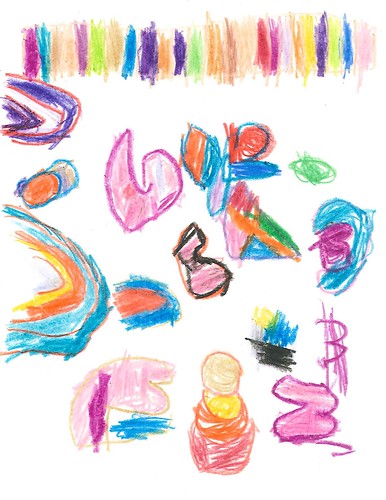 |
| Example 3: Miscellaneous |
The individual segments don’t have outlines like they do at the bottom of Example 4.
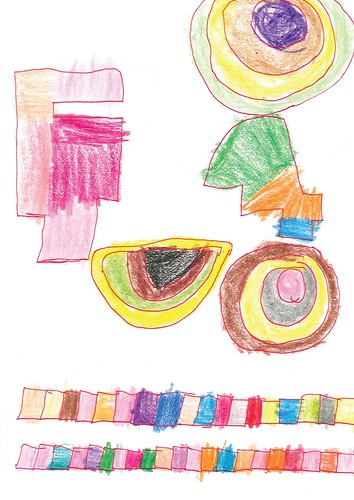 |
| Example 4: Miscellaneous |
The two circles within circles images, to the right, top and bottom, will develop as more and more circles, and more colors, are added. The angular geometrics will loose their color and become simplified in one way, more complex in another. The half-slice (center) will disappear, and those horizontal bars (bottom) will become vertical and more like railroad tracks.
This sheet repeats some of the motifs from the earlier sheets and adds letter forms:
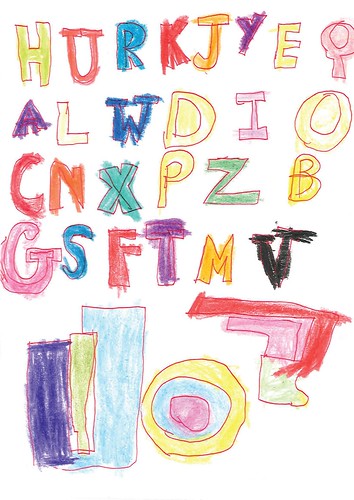 |
| Example 5: Add Letterforms |
We now have some sense of overall composition. There is a region for letters, the top, and another region for miscellaneous forms. And the letters are arranged in a regular array.
Now look at the next two sheets, dots:
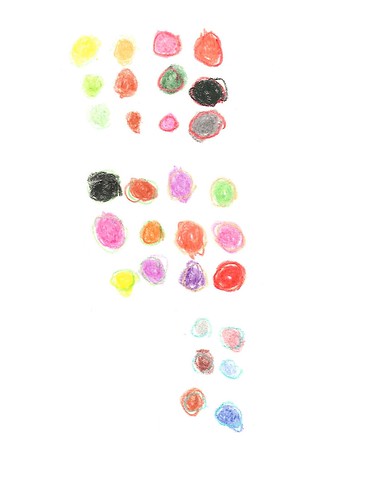 |
| Example 6: Colored Dots |
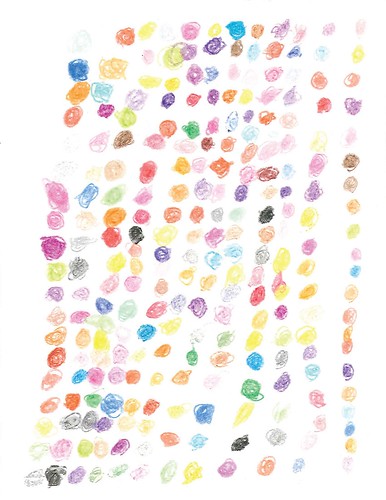 |
| Example 7: Colored Dots |
There are a number of things to note here. First of all, these sheets contain colored dots and ONLY colored dots. Moreover, there are no sheets containing dots mixed with other motifs, or at least Michael hasn’t put any online. Yes, if you look at Examples 2 and 3 you’ll see some round dots. Most of them have both borders and fills. Moreover those dots, like the other figures on those sheets, seem to be there on the sheet, in their own local space, where they fit. Just like the other figures on those two sheets (2 and 3) and the figures on sheet 4. There is relatively little sense of overall composition. Figures go on the page where they fit.
The dot images are different. For his figural elements Jamie has chosen the simplest possible element, round colored dots. Now he’s attending to overall composition. In example 6 we see three distinct groups of dots, two with 12 dots each and one with only six. Note also that most of the dots seem to consist of both borders and fills. Example 7 is quite different. There are many more dots, none of them have outlines, and the page is filled with them. But his control is not quite as good as it is with the more mature dots sheets.
Jamie is now in a position to discover the emergent global order we saw in those mature dots sheets. As long as he mixed motifs on a single sheet, placing each figure where it fit, with no sense of its relation to its neighbors, there was no emergent global order to discover. By simplifying his imagery to the simplest possible object and attending to how those simple objects are arranged on the page Jamie put himself in a position to make a discovery, which, obviously, he did. And so his mature sheets consist of only one kind of object per sheet (with the exception of the letters & swirls images, which we’ll get to in due time), allowing him to notice more global matters.
Let us consider two last examples. Example 8 consists entirely of colored bars:
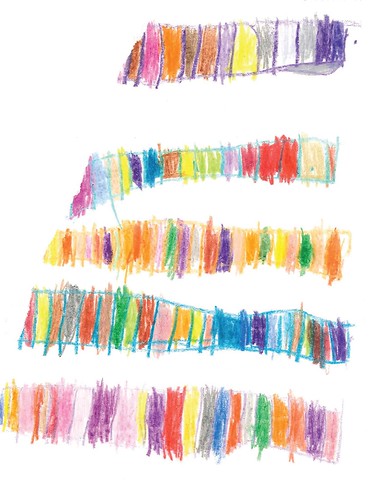 |
| Example 8: Color Bars |
This will be one of Jamie’s mature subjects. But the sequences will be vertically oriented rather than horizontal, and Jamie will make the outlines with a black felt-tipped pen rather than crayon, like the fills. I’ll leave commentary on this last example as an exercise for the reader:
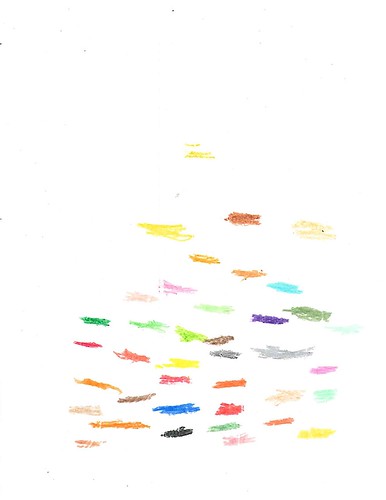 |
| Example 9: Color Bars, Horizontal |
The take-home lesson, then, is that Jamie’s Principle, if you will, act locally, but perceive globally, is something that he discovered in the process of, well, messing around. Just when and how that happened is by no means clear. That there was a time when he didn’t grasp it, that is clear from these early sheets, as are his steps on the way to discovery.
No comments:
Post a Comment